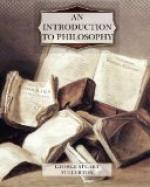Section 49. I wish that I could believe that every one of my readers would sometime give himself the pleasure of reading through Berkeley’s “Principles of Human Knowledge” and his “Three Dialogues between Hylas and Philonous.” Clearness of thought, beauty of style, and elevation of sentiment characterize them throughout.
The “Principles” is a systematic treatise. If one has not time to read it all, one can get a good idea of the doctrine by running through the first forty-one sections. For brief readings in class, to illustrate Berkeley’s reasoning, one may take sections 1-3, 14, 18-20, and 38.
The “Dialogues” is a more popular work. As the etymology of the names in the title suggests, we have in it a dispute between a man who pins his faith to matter and an idealist. The aim of the book is to confute skeptics and atheists from the standpoint of idealism.
For Hume’s treatment of the external world, see his “Treatise of Human Nature,” Part IV, section 2. For his treatment of the mind, see Part IV, section 6.
Section 50. Reid repeats himself a great deal, for he gives us asseveration rather than proof. One can get the gist of his argument by reading carefully a few of his sections. It would be a good exercise to read in class, if time permitted, the two sections of his “Inquiry” entitled “Of Extension” (Chapter V, section 5), and “Of Perception in General” (Chapter VI, section 20).
Section 51. For an account of the critical Philosophy, see Falckenberg’s “History of Modern Philosophy” (English translation, N.Y., 1893). Compare with this the accounts in the histories of philosophy by Ueberweg and Hoeffding (English translation of the latter, London, 1900). Full bibliographies are to be found especially in Ueberweg.
It is well to look at the philosophy of Kant through more than one pair of eyes. Thus, if one reads Morris’s “Kant’s Critique of Pure Reason” (Chicago, 1882), one should read also Sidgwick’s “Lectures on the Philosophy of Kant” (N.Y., 1905).
CHAPTER XIII, section 52. It is difficult to see how Hamilton could regard himself as a “natural” realist (the word is employed by him). See his “Lectures on Metaphysics,” VIII, where he develops his doctrine. He seems to teach, in spite of himself, that we can know directly only the impressions that things make on us, and must infer all else: “Our whole knowledge of mind and matter is, thus, only relative; of existence, absolutely and in itself, we know nothing.”
Whom may we regard as representing the three kinds of “hypothetical realism” described in the text? Perhaps we may put the plain man, who has not begun to reflect, in the first class. John Locke is a good representative of the second; see the “Essay concerning Human Understanding,” Book II, Chapter VIII. Herbert Spencer belonged to the third while he wrote Chapter V of his “First Principles of Philosophy.”




